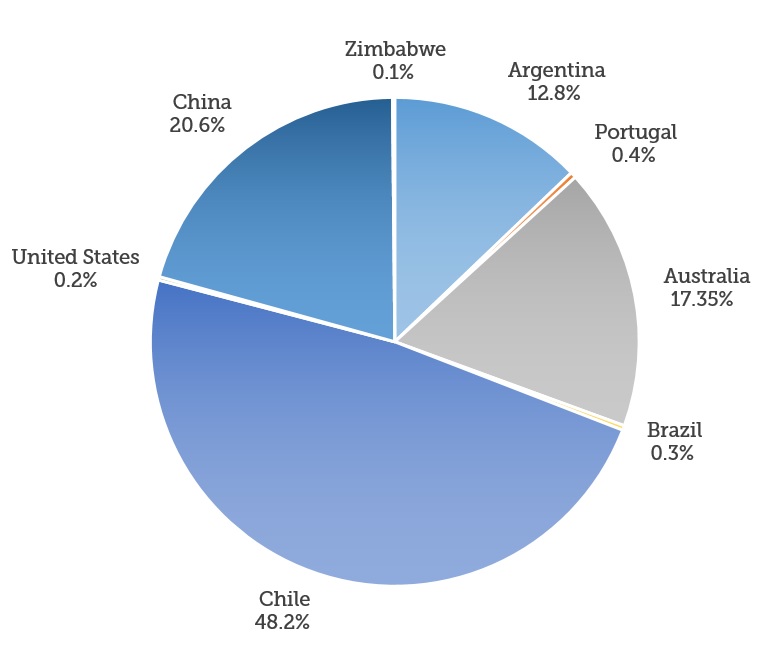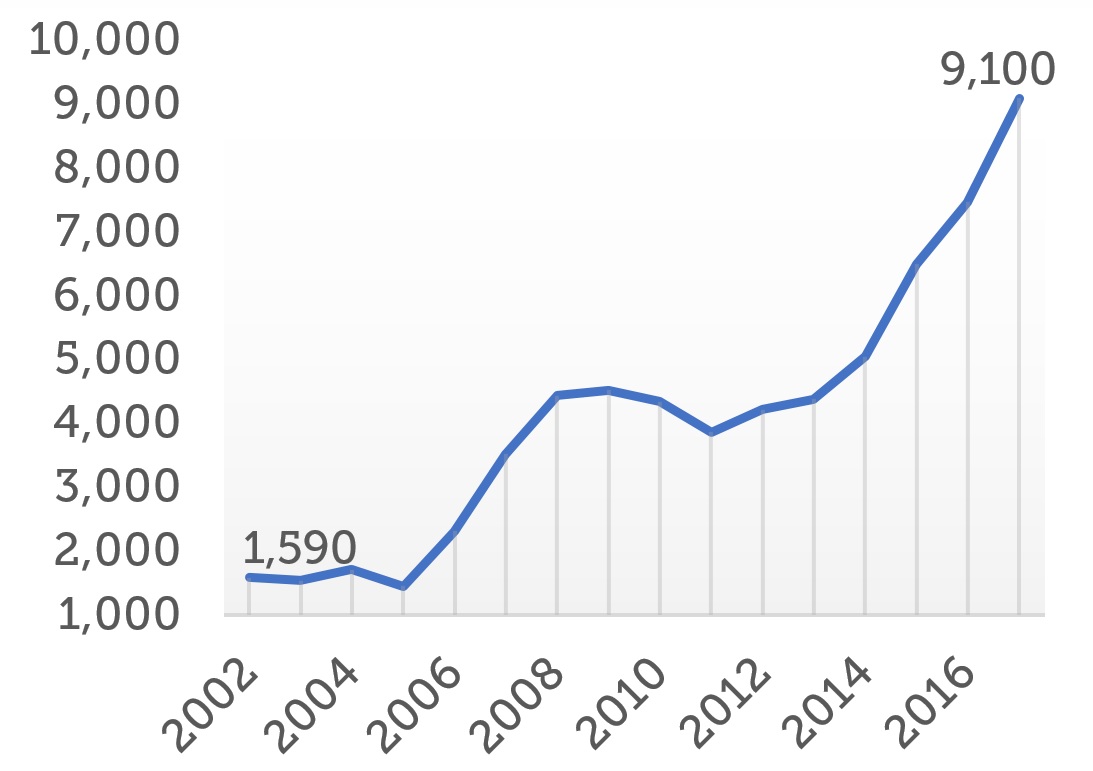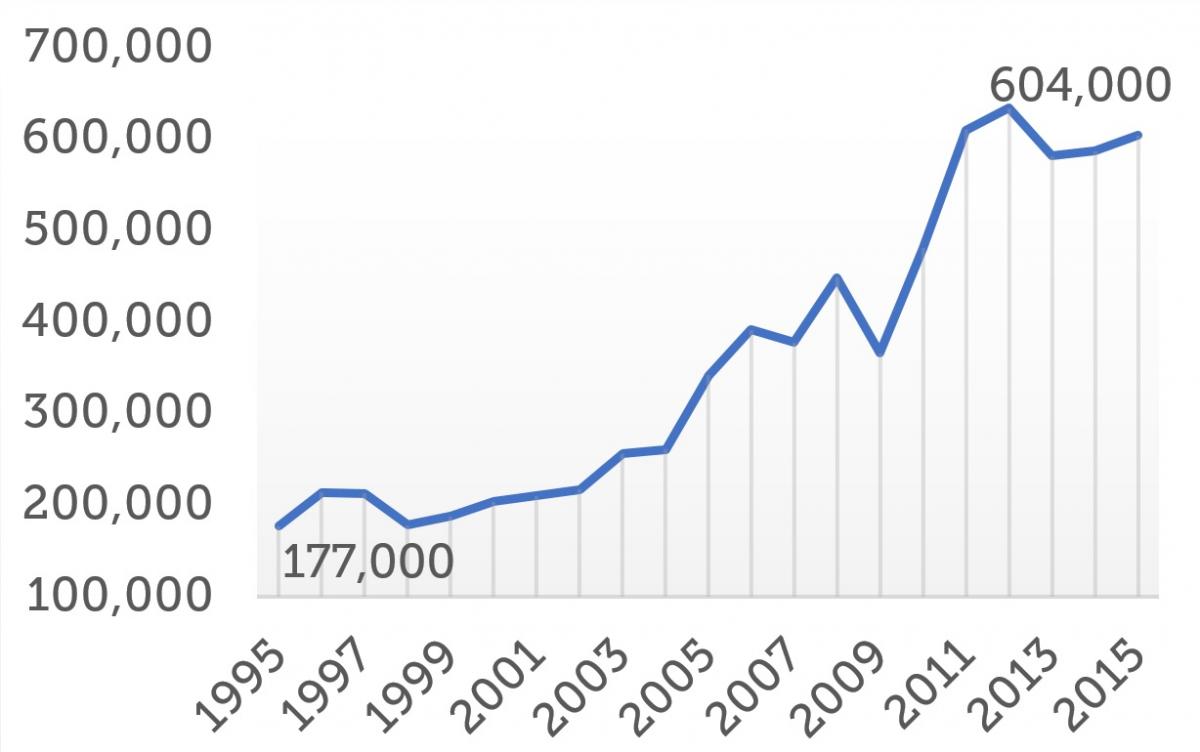The Rise of Lithium Batteries: A New Form of Energy Dependence?
The Rise of Lithium Batteries: A New Form of Energy Dependence?
Federico Mascolo*
A battery revolution lies at the core of the energy transition and it is well underway. While the positive impact of this is clear, what is less evident is that a new form of energy dependence could materialize as a result of an overreliance on a single key component: lithium.
To begin with, batteries are crucial to the transition towards cleaner mobility. The decarbonization of the transport sector depends on shifting from combustion to electric vehicles (EVs), whose engines are powered by the electricity stored in batteries. While combustion-powered vehicles remain the overwhelming majority, the transition has already begun.
EVs stock has doubled between 2015 and 2016,[1] a fact made possible by the substantial increase in battery production and the consequent fall in prices – up to 70 per cent in the past two years.[2] The surge in batteries production was not accidental. Demand for EVs is growing, and the trend is encouraged by decisions taken by both the automotive industry and policymakers – especially in Europe and China.
On the one hand, automakers such as Toyota, BMW and Volkswagen are revolutionizing their fleets by gradually introducing hybrid and fully electric vehicles. On the other, states are pursuing aggressive strategies to decarbonize the transport sector. For instance, China has set a target of 7 million EVs by 2025, the European Commission has recently proposed a legislative package that encourages the uptake of electric cars,[3] and member states such as France and the UK have announced the end of petrol cars sales by 2040.
Batteries can also have alternative uses. If the automotive sector has driven the development of the industry, it is in stationary storage that batteries could have their most noticeable impact. They will play a fundamental role in eliminating or reducing intermittence of renewable energy sources, which remains the main obstacle to their extensive use. In time, the possibility to store electricity – and to discharge it whenever needed – will allow a substantial integration of renewables into the energy grid.
The prospects are more than encouraging. Prices of both renewable technologies and batteries have dropped considerably, particularly since China has joined the fray. Moreover, the first projects have been completely successful, and delivered in a short time span. The building in 63 days of the world’s biggest battery system – Tesla’s 100 MW Powerpack in South Australia[4] – is only one example. Of course, electricity storage capacity is still at its very early stages – under 3 per cent of global electricity generation capacity. Nonetheless the global grid-scale battery fleet is growing rapidly, a proliferation largely driven by lithium-ion (or Li-ion) batteries.[5]
Li-ion is arguably the dominant technology for batteries, and it is likely to remain so in the future. This has to do with its valuable characteristics (especially its high energy density), but also the level of technological development and economies of scale, which make it far more competitive than alternative technologies. Li-ion batteries have been developed since the 1980s, when they became the main power source for our mobile phones. Now, driven by the expansion of the EVs industry, their production is growing at an unprecedented scale (and will increase fourfold by 2020),[6] especially as Chinese manufacturers (BYD and CATL) catch up with Japanese and Korean giants such as LG, Panasonic and Samsung.
This is not to say that there are no alternative technologies to store power – the zinc-bromide battery is one of them, and is already on the market.[7] These alternatives will in all likelihood occupy a share of the energy storage market, which by all indications will be huge. However, Li-ion batteries have acquired an advantage that will make them the dominant technology, to the point of reaching a potential market value of 40 billion dollars over the next decade according to Goldman Sachs.[8]
As Li-ion batteries acquire a central role in the energy transition, so does the raw material at their core: lithium. This does not come without risks. If the energy transition was meant, among other things, to reduce our dependence on fossil fuels, the battery revolution threatens to drive us towards a new form of addiction. In geological terms, there is no shortage of lithium. There are, however, a number of aspects that raise concern.
Starting from the obvious, to build a significant part of the energy transition on one resource, no matter how abundant, is a hazardous choice. This is especially true when the resource is geographically concentrated. Over 60 per cent of lithium reserves worldwide are located in Latin America (in Chile and Argentina),[9] the other main producers being China (22 per cent) and Australia (17 per cent).[10]
Such a high concentration of reserves in only four countries is not something that can be brushed aside: a disruption in one source country could result in severe lithium shortages worldwide. This is without mentioning the political concerns associated with giving such leverage to a small number of countries, some of which have also experienced instability and authoritarianism in the past.
Figure 1 | Lithium reserves by country

Source: Brian W. Jaskula, “Lithium”, cit.
Another source of concern is that worldwide production is not keeping pace with the steep growth in lithium demand (a phenomenon reflected by the twofold increase in the price of lithium since 2014).[11] Although the mining industry is likely to adapt – in 2017 production has increased after many years of stagnation in both Chile and Argentina – different studies worry that temporary shortages of supply are likely to become a constraining factor for the battery and EVs industries.[12] Temporary supply disruptions are also likely to result in price spikes as the one that occurred last year in China, where a momentary but acute shortage of imported lithium from Australia led to a 300 per cent increase in price.[13]
Figure 2 | Average lithium price per ton (dollars), 2002-2017

Source: Metalary, Lithium Price, https://www.metalary.com/?p=44.
Figure 3 | Lithium world production (tons), 1995-2015

Source: Brian W. Jaskula, “Lithium”, cit.
The issues mentioned represent the tip of the iceberg. The point is that, despite being conducive to a greener future, the battery revolution seems to be consolidating a new form of energy dependence. While it is true that lithium can be stocked, it will not be sufficient to keep the battery industry operative in the long-term.
This does not mean there are no ways out of this dependency. The obvious approach is to invest in innovation. Investing in battery technologies that do not implicate the use of lithium may alleviate the rate of “lithium addiction” but is unlikely to produce game-changing results. This is not only because of the abovementioned level of maturity and market dominance of Li-ion technology, but also due to the inherent advantages of lithium. Being the lightest of metals, its use allows for a better energy-per-volume and energy-per-weight ratios compared to all alternatives.
Instead, investments should focus on improving Li-ion batteries. While lithium will remain their essential component (i.e. as the electrolyte medium), progress can be made by substituting current cathode and anode materials. On the one hand, promising solutions already exist that can reduce the quantity of lithium per battery by substituting lithium-cobalt-oxide (LCO) cathodes. Among them is manganese-based (NMC) chemistry, whose employment in Li-ion batteries is expected to increase twenty-fold by 2020 due to the expansion of EVs industry.[14] On the other hand, new anode materials – such as silicon-based materials, successful at laboratory level but still too underdeveloped to have an impact – have the potential to increase Li-ion battery efficiency by storing up ten times the current capacity.[15] This could have a significant impact on the overall number of batteries – and, consequentially on the overall quantity of lithium required.
A further opportunity can come from recycling, which is not only indispensable to avoid waste damage, but could also turn out to be the best means to avoid heavy dependence on source countries. The sector is far from being developed, but recycling batteries is slowly becoming a political issue.
Recycling will play an important role in the EU battery alliance, announced in October 2017,[16] as well as in China, where the government has already started to invest in recycling facilities (which will be put in place by EVs manufacturers).[17] Lithium is the most expensive battery material to recycle, but this is an obstacle that can be overcome as it begins to be perceived a strategic resource.
A combination of these approaches – investing in the improvement of lithium ion batteries and their recycling – would allow us to approach the energy transition as an opportunity for a cleaner, greener and more sustainable future, and not as another cause of potential insecurity.
* Federico Mascolo is a MA student in International Security at the Paris School of International Affairs (PSIA), Sciences Po. He has been intern at the Istituto Affari Internazionali (IAI).
[1] Nicolò Sartori, “Energia: l’Europa prova a caricare le batterie, l’Italia arranca”, in AffarInternazionali, 11 October 2017, http://www.affarinternazionali.it/?p=66568.
[2] Katie Fehrenbacher, “Tesla Moves beyond Electric Cars with New California Battery Farm”, in The Guardian, 31 January 2017, https://gu.com/p/5p22g.
[3] European Commission, Energy Union: Commission Takes Action to Reinforce EU’s Global Leadership in Clean Vehicles, 8 November 2017, http://europa.eu/!jh83bV.
[4] “Charged up and Ready – As Renewable Energy to Be Delivered Around the Clock”, in Investment Attraction South Australia, 1 December 2017, https://invest.sa.gov.au/?p=3515.
[5] International Energy Agency (IEA), World Energy Outlook 2016, Paris, IEA, 2016.
[6] Ibid.
[7] Dyani Lewis, “Salt, Silicon or Graphite: Energy Storage Goes beyond Lithium Ion Batteries”, in The Guardian, 6 April 2017, https://gu.com/p/68eqa.
[8] Henry Sanderson, Tom Hancock and Leo Lewis, “Electric Cars: China’s Battle for the Battery Market”, in Financial Times, 5 March 2017.
[9] The second richest country in terms of lithium resources is Bolivia. However, political and technological obstacles have so far impeded production. See Brian W. Jaskula, “Lithium”, in US Geological Survey, Mineral Commodity Summaries 2018, January 2018, p. 98-99, https://minerals.usgs.gov/minerals/pubs/commodity/lithium/mcs-2018-lithi.pdf.
[10] Ibid.
[11] Henry Sanderson, “Lithium: The Next Speculative Bubble?” in Financial Times, 6 January 2017.
[12] Camille Grosjean et al., “Assessment of World Lithium Resources and Consequences of Their Geographic Distribution on the Expected Development of the Electric Vehicle Industry”, in Renewable and Sustainable Energy Reviews, Vol. 16, No. 3 (April 2012), p. 1735-1744; Hanna Vikström, Simon Davidsson and Mikael Höök, “Lithium Availability and Future Production Outlooks”, in Applied Energy, Vol. 110 (October 2013), p. 252-266. For a European focus, see Bálint Simon, Saskia Ziemann and Marcel Weil, “Potential Metal Requirement of Active Materials in Lithium-ion Battery Cells of Electric Vehicles and Its Impact on Reserves: Focus on Europe”, in Resources, Conservation and Recycling, Vol. 104, Part A (November 2015), p. 300-310.
[13] Brian W. Jaskula, “Lithium”, cit.
[14] “The Lithium Ion Supply Chain”, in Benchmark Minerals, September 2016, p. 44-61, https://s1.q4cdn.com/337451660/files/doc_articles/2016/161214-Benchmark-approved-for-distribution-Lithium-ion-supply-chain.pdf.
[15] Lomonosov Moscow State University, “Lithium-ion Batteries Will Get More Efficiency Due to Silicon, Germanium, Carbon Nanowalls”, in Phys.org, 31 August 2017, http://phy.so/423379893.
[16] European Commission, Speech by Vice-President for Energy Union Maroš Šefčovič at the Industry Days Forum on the Industry-led initiative on batteries / the EU Battery Alliance, Brussels, 23 February 2018, http://europa.eu/rapid/press-release_SPEECH-18-1168_en.htm; Frédéric Simon, “European Battery Alliance Launched in Brussels”, in Euractiv, 12 October 2017, https://www.euractiv.com/?p=1182767.
[17] “China Puts Responsibility for Battery Recycling on Makers of Electric Vehicles”, in Reuters, 26 February 2018, https://reut.rs/2FuKS84.
-
Dati bibliografici
Roma, IAI, marzo 2018, 5 p. -
In:
-
Numero
18|14




